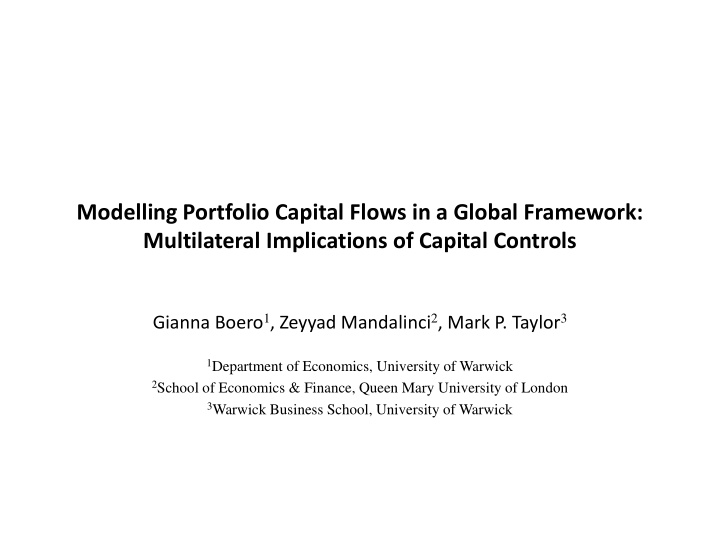



Modelling Portfolio Capital Flows in a Global Framework: Multilateral Implications of Capital Controls Gianna Boero 1 , Zeyyad Mandalinci 2 , Mark P. Taylor 3 1 Department of Economics, University of Warwick 2 School of Economics & Finance, Queen Mary University of London 3 Warwick Business School, University of Warwick
Introduction Key Statistics for Emerging Countries during/after the Crisis Cross-sectional averages of Arg, Bra, Chil, Egy, Indo, Kor, Mex, Thai and Turk. Chinn-Ito Capital Acc. Openness Measure. → A renewed interest in capital controls and optimal policy design.
Introduction • Recent series of IMF papers warn against: Deflection Effects • The presence of Deflection Effects is important – May lead to capital control wars – Implies the need for more international co-operation • Objective of this paper: – To develop a global model for PCFs & assess the presence of deflection effects – Additionally: • The underlying drivers of PCFs • Main Finding: There is no pervasive evidence of deflection effects
Literature & Theory • Studying policy issues on CFs involves disentangling their underlying drivers • CFs are a global phenomenon, various drivers & dependencies to account for – Especially important for studying multilateral issues. – Omitting relevant information may lead to imprecise conclusions. [e.g.: Price Puzzle in monetary policy literature]
Literature & Theory • Drivers of Capital Flows: [Calvo et al. (1993), Chuhan et al. (1998), Sarno & Taylor (1997), Edison and Warnock (2008), Forbes & Warnock (2012)] • Domestic-Pull Factors: – Domestic Return, Growth, Creditworthiness,... • Foreign-Push Factors: – Interest Rates, Global Risk Appetite, Growth,... • Other Dependencies among flows to different countries – Common Push Factors – Real, Financial or Regional Linkages – Contagion, due to [Claessens and Dornbusch (2000)] • Investor irrationality, herding. • Incentive and liquidity problems.
Literature & Theory
Literature & Theory
Empirical Methodology • GVAR Methodology – Accounts for pull, push and unobserved drivers of PCFs and fundamentals. – Estimated on a country-by-country basis. – We also account for the presence of I(0) CF variables.
Empirical Methodology
Empirical Methodology • Dataset – Sample: Q3-1987 - Q4-2010. – Countries: 25 Emerging, 17 Developed and Other. – Capital Controls Measure: Edison and Warnock (JEF, 2003) – Weights for cross-sectional averages: – Variables:
Drivers of PCFs Drivers of EF: GFEVDs - EF - 4Q • DC and Unobserved factors (EF*) dominate the role of Domestic variables. • However, there is notable heterogeneity across countries in drivers of PCFs.
Deflection Effects • Model Variations Considered: – Capital Controls: Chinn & Ito (2008). – Identification: Cholesky (controls first/last), Sign Restrictions, Block – Diagonal GVAR Variance-Covariance Matrix. – Foreign controls introduced as: Cross sectional averages or Bilateral. • In total, 22 alternative specifications are considered. • For most country pairs, no pervasive evidence of deflection effects.
Deflection Effects
Deflection Effects IRFs: Disaggregated Capital Controls Shocks for Selected Country Pairs [Fernandez et al. (2015), Schindler (2009)] Lines in different colours represent IRFs under alternative specifications for given country pair.
Conclusion Contributions and Findings: 1. Presented a comprehensive global econometric model for PCFs 2. Push factors are more important than pull factors for PCFs 3. Overall, no significant deflection effects for among most EMs 4. Some evidence of intra-regional deflection effects in Latin America
Appendix • Model Specification and Adequacy – Unit root tests: Flows are I(0) and fundamentals are I(1). – Lag orders: (2,1). – 7 dummies per country maximum. – Separate Models for EF and DF. – CI ranks are specified considering the stability of the GVAR. [Smith and Galesi (2011)] – Weak exogeneity is not violated.
Appendix
Appendix • Alternative Orderings for Triangular Identification: 1- SR - SM - Dcpi - Reer - CA - RSD - CR - Y - F - CC 2- CC - SR - SM - Dcpi - Reer - CA - RSD - CR - Y - F • Sign Restrictions • Signs for Supply, Demand and Monetary Policy shocks are from Rafiq & Mallick (2008), Peersman & Straub (2009) and Cassola & Morana (2004). • Signs for the Inflow shock are from the findings of Cardarelli et al. (2010). • Sign of the response of SM to CC shock is from Henry (2000).
Recommend
More recommend